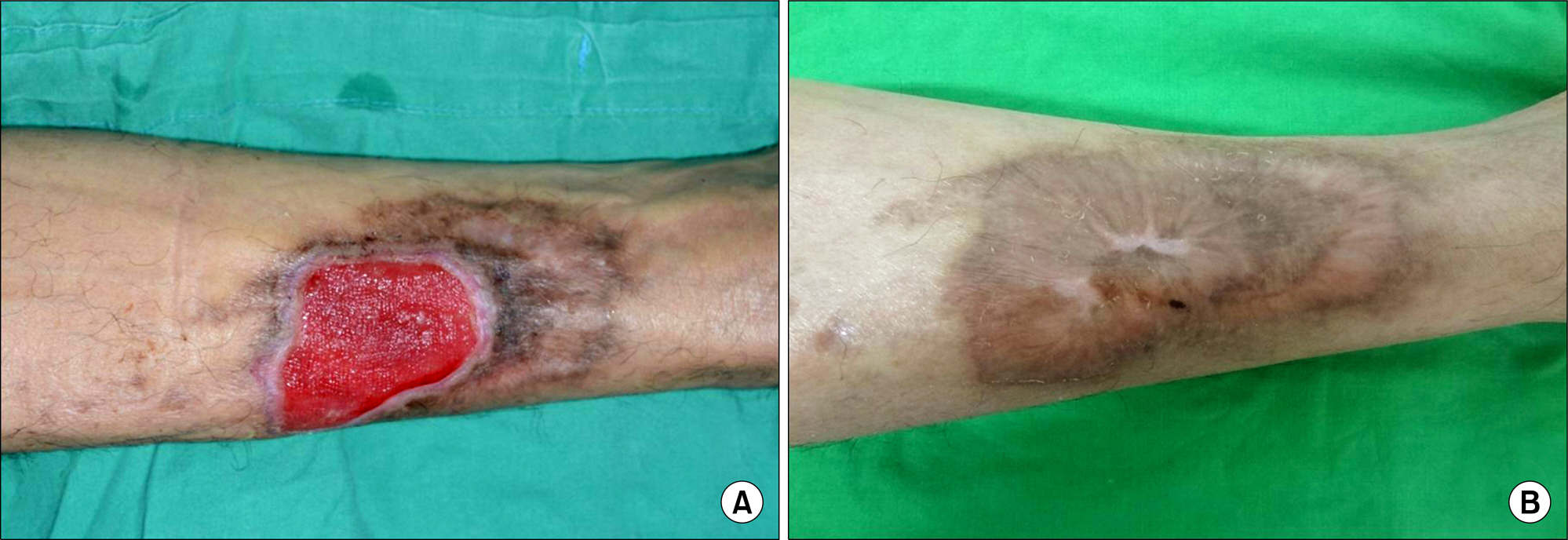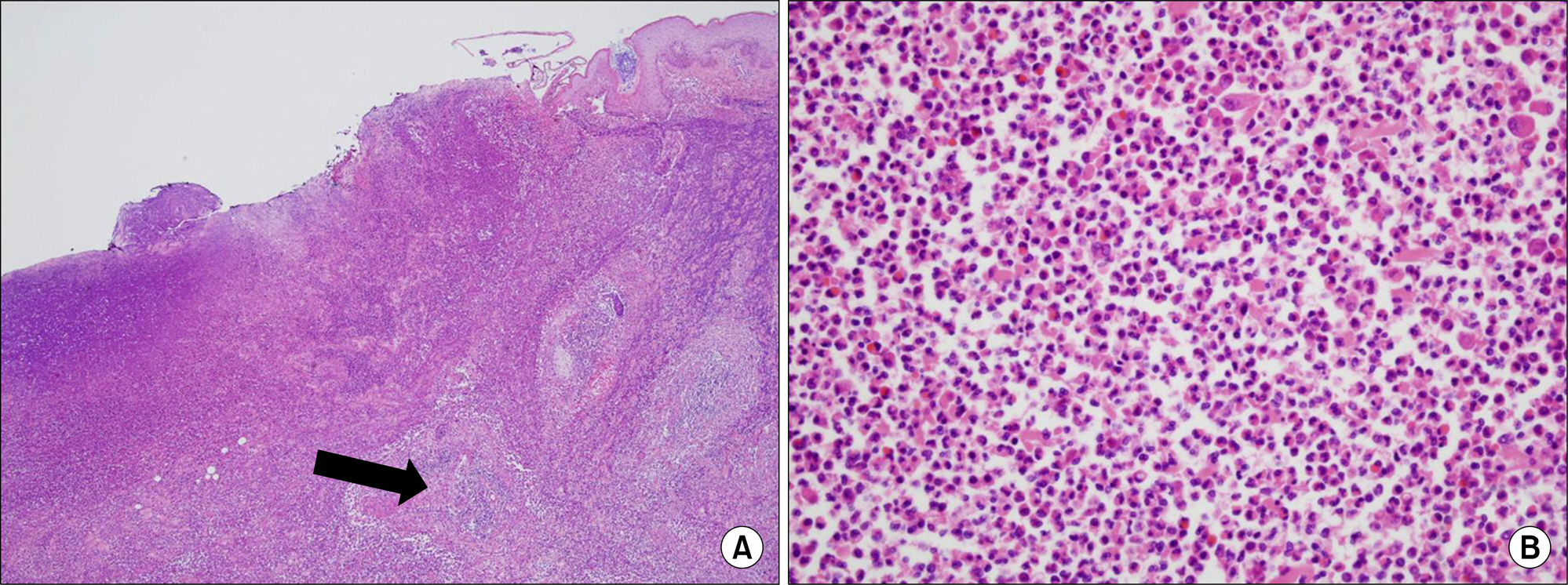J Rheum Dis.
2014 Jun;21(3):162-165. 10.4078/jrd.2014.21.3.162.
A Case of Propylthiouracil induced Antineutrophil Cytoplasmic Antibody Positive Pyoderma Gangrenosum
- Affiliations
-
- 1Division of Rheumatology, Department of Internal Medicine, Keimyung University School of Medicine, Daegu, Korea. mdkim9111@hanmail.net
- KMID: 2297530
- DOI: http://doi.org/10.4078/jrd.2014.21.3.162
Abstract
- Pyoderma gangrenosum (PG) is a rare disease that causes chronic skin ulcers, and it has recently been known to be related to changes in the immune system such as dysfunction of neutrophils. Over 50% of patients with PG have an underlying systemic disease, and rarely are there various medicines causing the disease, including iodide, bromide, and isotretinoin. A 49-year-old man had recurrent skin ulcers in his lower extremities. He had a history of taking propylthiouracil (PTU) for 10 years as a treatment for Graves' disease. Here, we describe a case of PTU-induced ANCA positive PG in a patient with hyperthyroidism, who has been improved after the cessation of PTU.
Keyword
MeSH Terms
Figure
Reference
-
1. Brunsting LA, Goeckerman WH, O'LEARY PA. Clinical and experimental observations in five cases occurring in adults. Arch Derm Syphilol. 1930; 22:655–80.2. Crowson AN, Mihm MC Jr, Magro C. Pyoderma gangrenosum: a review. J Cutan Pathol. 2003; 30:97–107.3. Wollina U. Clinical management of pyoderma gangrenosum. Am J Clin Dermatol. 2002; 3:149–58.
Article4. Darben T, Savige J, Prentice R, Paspaliaris B, Chick J. Pyoderma gangrenosum with secondary pyarthrosis following propylthiouracil. Australas J Dermatol. 1999; 40:144–6.
Article5. Lee SD, Lee JH, Kim KM, Yu DS, Park CJ, Park YM, et al. Pyoderma Gangrenosum: A Clinical Study. Korean J Dermatol. 2008; 46:1028–35.6. Kitahara T, Hiromura K, Maezawa A, Ono K, Narabara N, Yano S, et al. Case of propylthiouracil-induced vasculitis associated with anti-neutrophil cytoplasmic antibody (ANCA); review of literature. Clin Nephrol. 1997; 47:336–40.7. Sato H, Hattori M, Fujieda M, Sugihara S, Inomata H, Hoshi M, et al. High prevalence of antineutrophil cytoplasmic antibody positivity in childhood onset Graves' disease treated with propylthiouracil. J Clin Endocrinol Metab. 2000; 85:4270–3.
Article8. Jacobs EM, Hartkamp A, Kaasjager HA. PTU-associated cutaneous vasculitis with ANCA anti-MPO and anti-PR3 antibodies. Neth J Med. 2003; 61:296–9.9. Hong SB, Lee MH. A case of propylthiouracil-induced pyoderma gangrenosum associated with antineutrophil cytoplasmic antibody. Dermatology. 2004; 208:339–41.
Article10. Seo JW, Son HH, Choi JH, Lee SK. A Case of p-ANCA-Positive Propylthiouracil-Induced Pyoderma Gangrenosum. Ann Dermatol. 2010; 22:48–50.
Article11. Hoffman MD. Pyoderma gangrenosum associated with c-ANCA (h-lamp-2). Int J Dermatol. 2001; 40:135–7.
Article12. García-Morales I, Herrera-Saval A, Camacho F. Pyoderma gangrenosum over a saphenectomy scar in a cANCA-positive patient with diverticulitis. Actas Dermosifiliogr. 2005; 96:258–60.13. Choi HK, Merkel PA, Tervaert JW, Black RM, McCluskey RT, Niles JL. Alternating antineutrophil cytoplasmic antibody specificity: drug-induced vasculitis in a patient with Wegener's granulomatosis. Arthritis Rheum. 1999; 42:384–8.
Article14. Gunton JE, Stiel J, Clifton-Bligh P, Wilmshurst E, McElduff A. Prevalence of positive anti-neutrophil cytoplasmic antibody (ANCA) in patients receiving anti-thyroid medication. Eur J Endocrinol. 2000; 142:587–90.
Article15. Koca E, Duman AE, Cetiner D, Buyukasik Y, Haznedaroglu IC, Uner A, et al. Successful treatment of myelodysplastic syndrome-induced pyoderma gangrenosum. Neth J Med. 2006; 64:422–4.
- Full Text Links
- Actions
-
Cited
- CITED
-
- Close
- Share
- Similar articles
-
- A Case of p-ANCA-Positive Propylthiouracil-Induced Pyoderma Gangrenosum
- A Case of Propylthiouracil-induced Lupus Erythematosus Accompanied by Antineutrophil Cytoplasmic Antibody-positive Vasculitis
- Wegener's Granulomatosis Presenting as Pyoderma Gangrenosum
- A Case of Propylthiouracil Induced Diffuse Pulmonary Hemorrhage
- A Case of Behcet's Disease Associated with Pyoderma Gangrenosum



